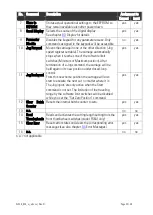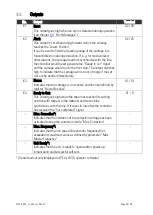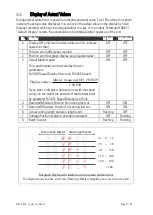
Fs340_02b_oi_e.docx / Nov-21
Page 22 / 49
Descripotion of the Parameters
Prior to register setting you must decide which dimensions or length units (LU) you like to use
for preset of the cutting length. This could be 0.1mm or 1mm or 0.001 inch or any other
resolution you desire. All further settings refer to the Length Units you decided to use. E.g.
when you chose to set the length with a 0.1 mm resolution, 1000 LUs will represent a length of
100.0 millimeters with all further entries.
Length Setting
F01
Range
Default
F01.000 Cutting Length:
Preset of the desired cutting length scaled in length units.
1 … 999999
10000
Operational Setting
F02
Range
Default
F02.002 Pulses Line / 1000:
Scaling of the line encoder. Find out how many pulses you
receive when the line moves 1000 length units (LU)
forward and set the proper number of pulses here.
1 … 999999
1000
F02.003 Pulses Cut / 1000:
Scaling of the carriage encoder. Find out how many pulses
you receive when the carriage moves 1000 length units
(LU) forward and set the proper number of pulses here.
1 … 999999
1000
F02.004 Acceleration 1:
Acceleration rate of the carriage during forward motion.
Scaled in Length units per second squared (LU/s²).
1 … 99999
5000
F02.005
Acceleration 2:
Acceleration rate of the carriage during reverse motion.
Scaled in Length units per second squared (LU/s²).
1 … 99999
5000
•
The controller generates ramps of a constant gradient. Therefore, the ramp times
depend on the acceleration settings and the actual line speed. When, for example,
the unit is scaled to entire millimeters, an acceleration setting of 5000 mm/s²
would mean that the carriage accelerates from zero to a speed of 5 m/s (= 300
m/min) within 1 second. Therefore it would need 100 ms when the real speed is
30 m/min only etc.
•
You must only use acceleration settings that the drive is really able to follow.
Settings outside of the physical capability of the drive will result in malfunction or
even failure of the whole system.
•
The acceleration settings refer to linear ramp forms. When you use S-ramps (see
next parameter), the maximum acceleration at the steepest position of the S-
profile will be by factor 1.25 higher.






























